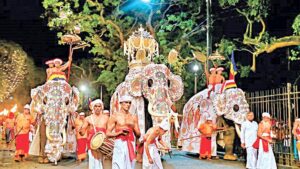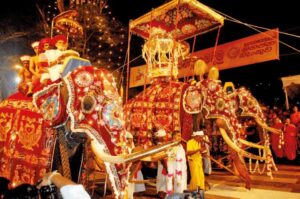Kandy Perahera, also known as the Esala Perahera, is one of the most iconic cultural festivals in Sri Lanka, celebrated annually in the city of Kandy. The festival, which dates back to ancient times, is a celebration of the Buddhist tooth relic of the Buddha, which is housed in the Temple of the Tooth in Kandy. Kandy Perahera is a 10-day festival that culminates in a grand procession featuring elaborately decorated elephants, dancers, drummers, and other performers. One of the most significant events of the festival is the Diya Kapeema or the water-cutting ceremony, which takes place at the Mahaweli River. In this blog post, we will explore the significance of Diya Kapeema and how it is celebrated during Kandy Perahera.
What is Diya Kapeema?
Diya Kapeema is an ancient ritual that involves cutting the waters of the Mahaweli River, which is considered the longest river in Sri Lanka. This ritual is performed to signify the purification of the river and to bless the people of Sri Lanka. The ceremony takes place on the day before the final procession of Kandy Perahera. During the ceremony, a group of people known as the Diyawadana Nilame, who is the chief lay custodian of the Temple of the Tooth, and other officials, carry out the ritual.
The Significance of Diya Kapeema
Diya Kapeema is a significant event during Kandy Perahera because it symbolizes purity and blessings. The Mahaweli River is an essential source of water for the people of Sri Lanka, and cutting its waters is believed to purify it. This ritual is a way of seeking blessings for the people of Sri Lanka, and it is believed that cutting the waters of the Mahaweli River brings prosperity and good luck. The ritual is also an essential part of the cultural heritage of Sri Lanka, and it is performed with great devotion and reverence.
The Ceremony of Diya Kapeema
The ceremony of Diya Kapeema takes place at the Mahaweli River, where a designated spot is cordoned off for the ritual. The Diyawadana Nilame and other officials carry a silver axe, which is used to cut the waters of the river. Before the ceremony begins, the Diyawadana Nilame and other officials perform a series of rituals to seek blessings and purify themselves.
Once the preparations are complete, the Diyawadana Nilame cuts the waters of the river with the silver axe, and the other officials pour water from silver vessels into the river. This symbolizes the purification of the river and the blessings of the gods. The Diyawadana Nilame and other officials then perform a series of other rituals, including the offering of flowers and incense, to seek blessings for the people of Sri Lanka.
Conclusion
In conclusion, Kandy Perahera’s Diya Kapeema ceremony is a testament to the rich cultural heritage of Sri Lanka. It is a beautiful and significant ritual that symbolizes purity and blessings, and it is performed with great devotion and reverence. The Mahaweli River, the longest river in Sri Lanka, is an essential source of water, and cutting its waters is believed to purify it and bring prosperity and good luck. Witnessing the Diya Kapeema ceremony during Kandy Perahera is an unforgettable experience and a beautiful reminder of the spiritual and cultural significance of Sri Lanka’s ancient traditions.




